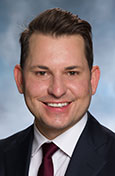New Screening Options for Smokers and Former Smokers
 More people now qualify for lung tests that can detect cancer early.
More people now qualify for lung tests that can detect cancer early.
If you’re a smoker who uses cigarettes now or gave them up years ago, you may be at greater risk of health problems, especially lung cancer. Yet many current and former smokers are unaware of a lung cancer screening that can save lives. “It’s a quick screening that can result in early detection,” says Benjamin Medina, MD, a thoracic and vascular surgeon at Robert Wood Johnson University Hospital (RWJUH) Hamilton’s Cancer Center. “Updated screening guidelines may mean you’re newly eligible to receive the test.”
How are lung cancer screenings done?
They consist of an annual, low-dose CT scan. You lie on a table while an X-ray machine takes images of your lungs. The scan only takes about five minutes, is very low dose and is very safe. Insurance covers recommended lung cancer screenings in most cases.
What happens after images are taken?
A radiologist looks for small lumps called nodules. These are not necessarily cancerous, but they can become cancerous over time. Depending on a nodule’s size and characteristics, your doctor may recommend having a biopsy; undergoing another CT scan in three to six months to see if the nodule has grown or changed; or waiting and having it reassessed at next year’s screening.
What if the test finds lung cancer?
Lung cancer is easier to treat or even cure when it’s detected early. If part of a lung has to be removed, earlier detection means the excised area will be smaller than if the cancer were found later. Taking out less lung helps preserve lung function. Early detection also means there is less chance the cancer has spread to other areas of the body. When lung cancer spreads, survival rates become much lower.
Who should undergo lung cancer screening?
Patients should be 50 to 80 years old and currently smoke or have quit within the past 15 years. They also should have a 20 pack-year history or more of smoking. A pack-year is equivalent to smoking an average of one pack of cigarettes a day for a year. So if you smoked a pack a day for 20 years, that’s a 20 pack-year history—and so is having smoked two packs a day for 10 years. These guidelines were updated in 2021.
Why did guidelines change?
To increase screening opportunities for people who are at highest risk of lung cancer and reduce disparities. Broader eligibility should especially enhance early detection at younger ages among women and Black adults, who are likelier to develop lung cancer after less cumulative tobacco exposure.
How can RWJUH Hamilton help me quit smoking?
Through RWJBarnabas Health’s Institute for Prevention and Recovery, we offer a 12-week program in which you’ll get a personalized plan, free nicotine patches and behavioral therapy that can help you manage challenges and prevent relapse. Someone will call you regularly to go over your goals and keep you on track. “It’s a wonderful program,” says Dr Medina. For more information about Robert Wood Johnson University Hospital Hamilton’s Lung Cancer Screening Program, call 855.RWJ.LUNG (855.795.5864).
RWJBarnabas Health and Robert Wood Johnson University Hospital Hamilton, together with Rutgers Cancer Institute of New Jersey— the state’s only NCI-Designated Comprehensive Cancer Center— provide close-to-home access to the latest treatment options.
For more information, call 844.CANCERNJ or visit www.rwjbh.org.
Contact: Sherry Smith, Director, Public Relations & Marketing
Robert Wood Johnson University Hospital Hamilton
Direct: 609-584-6583 / Email: sherry.smith2@@rwjbh.org